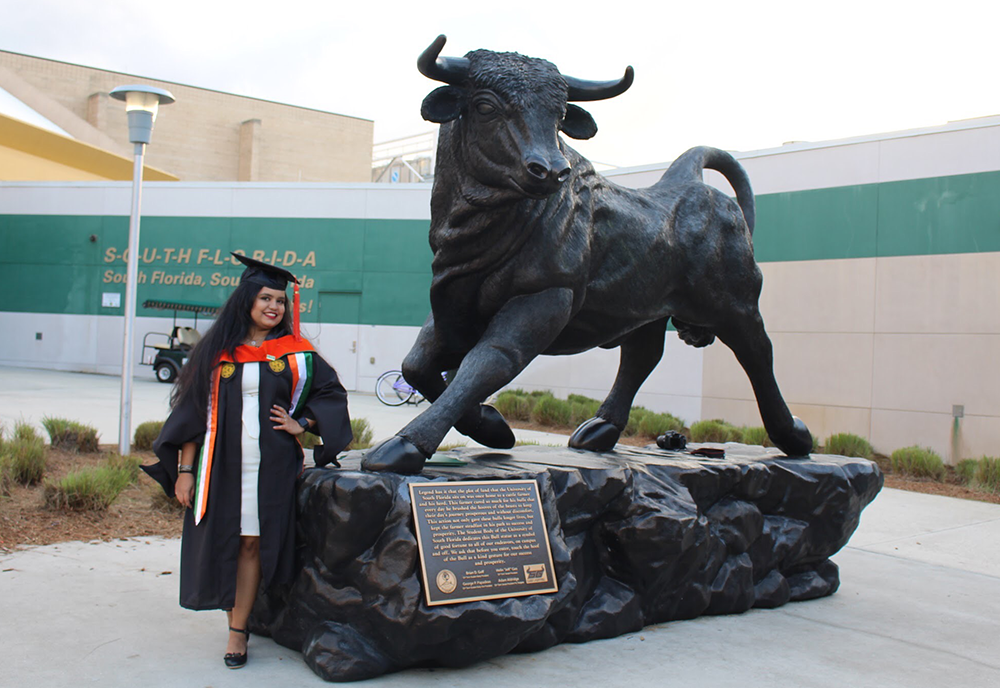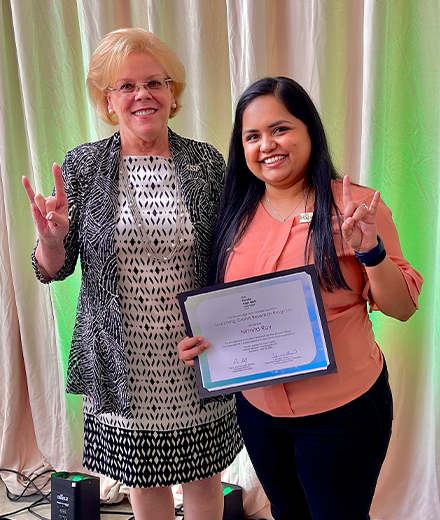
USF World: Nirmita, congratulations on becoming Dr. Roy. But before we discuss your doctorate, can we go back to where and how your STEM journey started in India? In an environment where girls gravitate to the humanities, how did you enter the world of electronics and engineering?
Nirmita: Thank you so much for your wishes! My journey into STEM began in Bangalore (now known
as Bengaluru) in south India. Growing up, I was always encouraged to explore various
subjects. My father, who was a test engineer for aircrafts in the government sector,
played a significant role in introducing me to the world of electronics. As a child,
I would watch him solder PCBs (Printed Circuit Boards) and occasionally accompanied
him to his workplace. These experiences ignited a fascination for electronics and
engineering in me. My curiosity, combined with these early influences and a supportive
environment, propelled me towards this field. My teachers and parents never set boundaries
on what I could achieve, regardless of societal expectations.
USF World: Once you decided to go to America, how did you choose USF and what were your challenges?
Nirmita: Choosing USF was influenced by both academic excellence and the university's dedicated
Nanotechnology Research and Education Center (NREC). My final undergraduate project focused on cryonics and nanotechnology, and USF's
strong emphasis on these areas made it an ideal choice. The challenges were manifold
– adjusting to a new culture, managing finances, and coping with the rigorous demands
of graduate studies. However, the support from faculty, fellow students, and the broader
USF community made the transition smoother.
USF World: Your journey at USF started as a master’s student and after working in industry,
you pursued your PhD. Please talk about that transition and what it has meant to go
from being a STEM student to a pioneer with your PhD project.
Nirmita: The transition from a master's student to a PhD candidate was both challenging and rewarding. After completing my master's, I took a break to gain industry experience, which offered invaluable insights into practical applications of my academic knowledge. Returning to USF for my PhD was driven by a desire to delve deeper into research and contribute to innovative solutions. My PhD project on 'Electrochemical Copper Printing for Wearable Electronics' combined multiple disciplines to create an innovative approach to electronics. This journey has been transformative, not just in terms of academic growth but also in shaping my identity as a researcher and innovator.
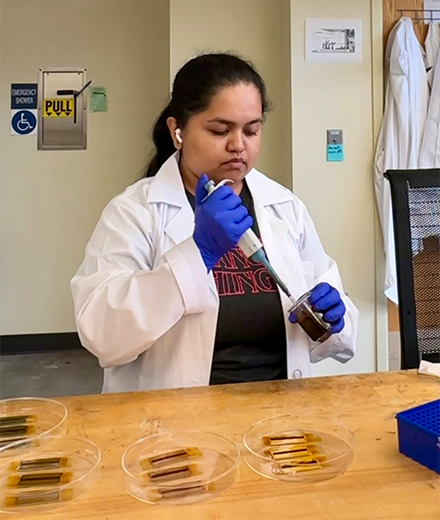 Committing to pushing the boundaries of science and turning ideas into innovation,
one pipette at a time.
Committing to pushing the boundaries of science and turning ideas into innovation,
one pipette at a time.USF World: Tell us about your PhD project – how and why you chose the topic, the challenges you faced, and then the final triumph. Do mention using your fiancé as your ‘model’’!
Nirmita: My PhD project focused on developing electrochemical methods for printing copper onto
flexible substrates, aimed at creating advanced wearable electronics. The idea stemmed
from a personal frustration with traditional sleep tests and Holter monitors, which
required an enormous number of wires and were always bulky. When my major professor,
Dr. Arash Takshi, spoke about this project and its endless applications, I was immediately
drawn to it. There were many challenges, from technical hurdles in the lab to the
frustration of experiments not yielding the expected results. However, perseverance
paid off. A particularly memorable aspect was using my fiancé, Sid, as a model for
testing the wearability and durability of the prototypes. His patience and encouragement
were instrumental in pushing through the tough phases. The final triumph came when
our work was recognized for its innovation and potential impact on the field.
USF World: What has been the reaction to your journey back home – among your family, your school,
and college teachers ?
Nirmita: The reaction back home has been overwhelmingly positive and supportive. My family,
who always believed in my potential, celebrated each milestone with pride. My teachers
from school and college expressed their joy, saying that my journey has become an
inspiring story for many other students. It’s heartwarming to see that my achievements
are not just personal victories but also a source of motivation for others to pursue
their dreams, irrespective of the challenges.
USF World: There has been a sharp focus on women in STEM in the past couple of years… Do you
see more women making strides in this area – both in the U.S. and your home country?
If there is still a bias against them, is it in the academic field or industry?
Nirmita: Indeed, there has been a significant increase in the focus on women in STEM, and I do see more women making strides in both the U.S. and India. In the U.S., there are numerous initiatives aimed at supporting women in STEM through scholarships, mentorship programs, and networking opportunities. This has led to a noticeable increase in female participation and leadership in STEM fields. In India, there is also a growing emphasis on encouraging women to pursue STEM education and careers. However, biases still exist, often manifesting differently across academia and industry. In academia, women sometimes face subtle biases in recognition and funding opportunities, while in industry, they may encounter barriers in leadership roles and work-life balance. Despite these challenges, the growing awareness and supportive networks are gradually bridging these gaps, encouraging more women to enter and excel in STEM fields.
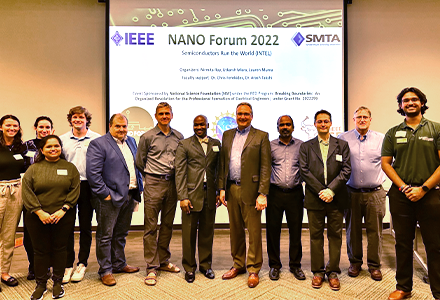
USF World: What was the male-to-female ratio in the labs you have worked in?
Nirmita: During my master’s program, the gender ratio in the labs was approximately 80:20 (women:
men), as my professor, Dr. Sylvia Thomas, believed strongly in promoting women in
STEM. This supportive environment significantly influenced my journey. During my PhD,
the ratio improved to about 50:50, reflecting a more significant growth and balance
in gender representation. This positive shift is indicative of the growing interest
and participation of women in STEM fields, driven by institutional support and changing
societal norms.
USF World: At a recent seminar that I attended in India on this theme, a common expressed concern
was that while many women enter STEM courses in colleges in India (especially south
India, where you hail from), a small percentage take it forward in terms of research
or careers as it is seen as a field where they may find it difficult to balance “family
responsibilities” with work demands. In fact, many of them opt for non-STEM careers.
What is your take on that?
Nirmita: Balancing family responsibilities with work demands is indeed a significant challenge
for many women in STEM. The societal expectations and lack of support structures often
compel women to opt for non-STEM careers. However, this scenario is gradually changing
with increased awareness, flexible work policies, and supportive family dynamics.
The challenges are more pronounced in academia, where the demands of research and
publication can be intense. However, with more support from families and spouses,
things are turning around. It is crucial to create a culture where women do not have
to choose between their careers and family responsibilities. Mentorship, networking
opportunities, and institutional support play vital roles in enabling women to sustain
and thrive in STEM careers.
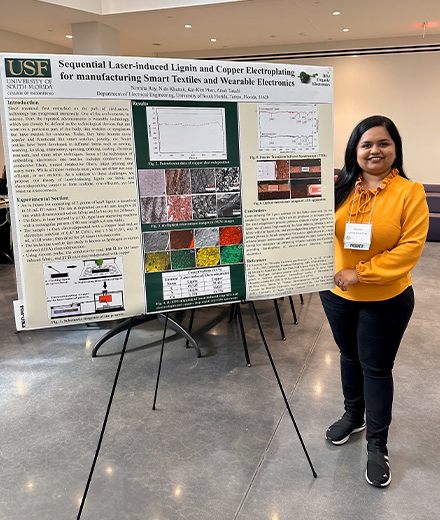
USF World: Your 2018 video talking about being a student at USF was very popular with potential students and seems to have been the starting point of your interaction with incoming students. USF India often turned to you to talk to these students and answer their questions at webinars and other events. Please talk about that experience and why you have always embraced that role so passionately. Are some of them still in touch with you?
Nirmita: Engaging with potential students and sharing my experiences at USF has been incredibly
fulfilling. The video served as a bridge, connecting me with numerous students who
were eager yet apprehensive about their journey. My own journey moving and adjusting
to the American education system and cultural differences was challenging. This experience
motivated me to always be there for others. Many of these students are still in touch,
messaging me on various social media platforms like Instagram, Facebook, and LinkedIn,
seeking advice about the programs, life in the USA, and more. I have always been passionate
about supporting women and girls in STEM, and I wish to continue to motivate more
girls to be a part of this field.
USF World: You were featured in quite a few articles in Indian magazines, becoming an unofficial
spokesperson for USF – is that a role you plan to continue?
Nirmita: Absolutely! Representing USF and sharing my experiences has been an honor. I plan
to continue this role, as it allows me to give back to the institution that played
a pivotal role in my growth. I was and will always be a USF Bulls representative (Go
Bulls!). Moreover, it’s an opportunity to inspire and guide prospective students,
especially women, to pursue their ambitions in STEM. By sharing my journey, I hope
to demystify the challenges and highlight the immense possibilities that lie ahead.
USF World: What role do you think alumni should play in taking USF ahead?
Alumni play a crucial role in the advancement of their alma mater. By engaging in mentorship, networking, and fundraising activities, alumni can offer invaluable support to current students and the institution.
Nirmita: Alumni play a crucial role in the advancement of their alma mater. By engaging in
mentorship, networking, and fundraising activities, alumni can offer invaluable support
to current students and the institution. Sharing industry insights, providing internship
opportunities, and participating in academic and extracurricular events can enhance
the university’s reputation and impact. Moreover, alumni can serve as ambassadors,
promoting the university globally and fostering collaborations that drive innovation
and growth.
USF World: What are your plans now? What is the next STEM frontier you want to cross?
Nirmita: As I look ahead, my immediate plan is to continue my research and contribute to advancements in wearable electronics and semiconductors. I am looking at both industry and academic opportunities and will continue to motivate more women to be on their feet. As semiconductor chips are growing smaller and smaller, the opportunities are getting bigger and bigger. There is no limit to success. I am particularly interested in exploring the integration of sustainable materials and innovative fabrication techniques to create more efficient and eco-friendly devices. Beyond that, I aspire to take on a role that combines research with teaching, mentoring the next generation of scientists and engineers. The STEM frontier is vast, and I am excited to navigate new challenges and opportunities that lie ahead.
